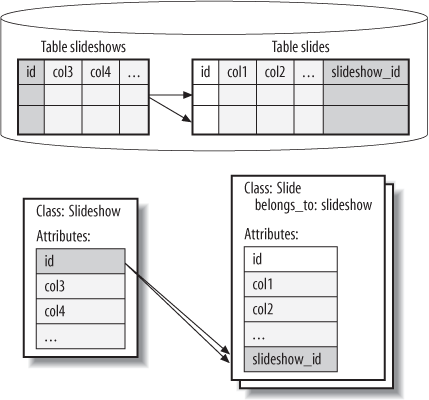Now that youâve finished the relationships on Slide, youâll need to implement has_many relationships on Photo and Slideshow. Figure 4-2 shows the mapping between Active Record
objects and database tables with has_many.
Figure 4-2. The entity (slideshow) has_many :associations (slides) relationship is a one-to-many relationship
has_many is the other side of a
belongs_to relationship. Both models
and the schema exist, so you donât need to modify the class or table for
Slide. You can merely add the
relationship has_many to
slideshow.rb in
app/models/slideshow.rb:
class Slideshow < ActiveRecord::Base has_many :slides end
Youâll do the same to app/models/photo.rb:
class Photo < ActiveRecord::Base ... has_many :slides validates_presence_of :filename ... end
We should explain a little bit about the model. A slide belongs to a photo, but a photo has many slides. With this design, you give users the ability to use the same photo in several different slideshows. Remember: a slide is a photo and a position in a specific slideshow. So, a slide canât be reused, but a photo can.
With those code changes, you can see all of the slides associated with a photo and all of the slides in a slideshow. As usual, you can open the console to see the model in action:
>> reload!
Reloading...
=> true
>> slide = Slide.find 1
=> #<Slide id: 1, position: 1, photo_id: 1, slideshow_id: 1,
created_at: "2008-05-10 17:45:34", updated_at: "2008-05-10 17:45:34">
>> slideshow = slide.slideshow
=> #<Slideshow id: 1, name: "Interesting Pictures", created_at: "2008-05-10 17:45:34",
updated_at: "2008-05-10 17:45:34">
>> slideshow.slides.each {|s| puts s.photo.filename}
train.jpg
lighthouse.jpg
gargoyle.jpg
cat.jpg
cappucino.jpg
building.jpg
bridge.jpg
bear.jpg
baskets.jpg
=> [#<Slide id: 1, ...]So, you get a list of slides in the slideshow, and each has an
associated photo. Active Record is now managing the has_many relationship between Slideshow and Slide. You could use photo.slides in the same way. Table 4-2 shows you the metaprogramming for
has_many.
Table 4-2. Metaprogramming for has_many
Added feature | Description |
|---|---|
Methods | |
Adds an object to the | |
Deletes an object in the | |
Replaces the | |
Uses the same rules as a basic find, but
operates only on the items in the | |
Deletes all of the objects in the
association: | |
Tests to see if | |
Returns the number of items in the
| |
Builds an object of the associated type
without saving it. It takes a hash map of attributes for the new
object as a parameter: | |
Creates and save an object of the
associated type, initialized to the root object. It takes a hash
map of attributes for the new object as a parameter: In this example, | |
Attributes | |
Get Rails: Up and Running, 2nd Edition now with the O’Reilly learning platform.
O’Reilly members experience books, live events, courses curated by job role, and more from O’Reilly and nearly 200 top publishers.


